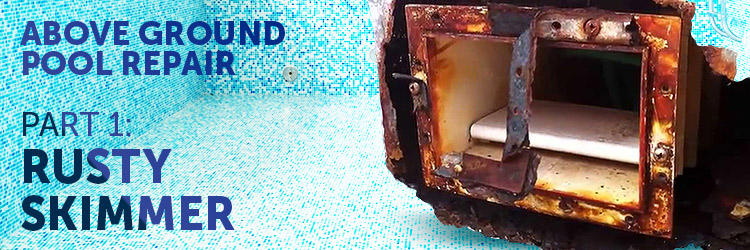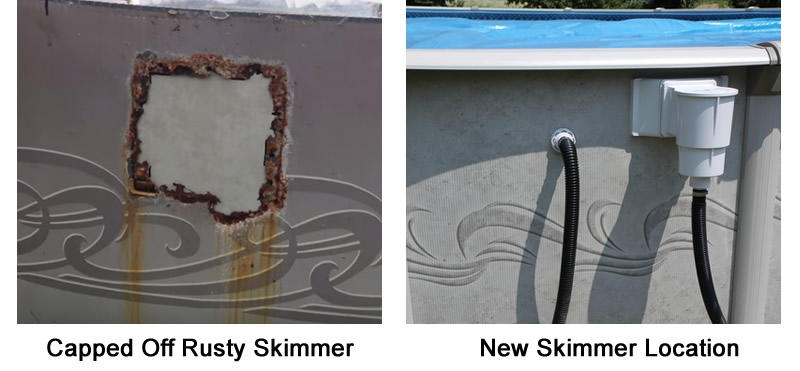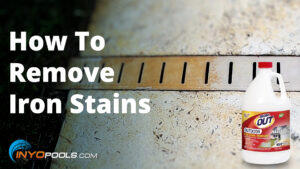Above Ground Pool Rust Around Skimmer
At some point in the life of your above ground pool, odds are that you will start to see rust form around your skimmer. This occurs as moisture gets between the liner and the pool wall. Most of the time this moisture is as a result of a leakage around the skimmer or return fitting or a small leak in the liner. The good thing about rust around the skimmer is that the skimmer is located at the top of the pool wall where there is very little water pressure compared to the bottom of the pool wall. This means that this repair can be done easily at little cost. There are two ways I suggest to tackle the repair of a rusty skimmer. Either you can patch the rusted skimmer opening and cut a new skimmer hole in a good section of the pool wall or you can rebuild the rusted skimmer opening. Below we outline each method.
Cap Rusty Skimmer Opening & Cut a New Opening (Suggested Method)
This is my favorite method of repairing a rusty skimmer. What you will be doing is removing the skimmer from its current location, capping off the old skimmer hole with sheet metal and then cutting a new skimmer opening in a good section of wall, normally one or two wall sections down from the original skimmer placement. Here are the step-by-step instructions when using this approach.
Drain the pool water to below the skimmer, take off a few top rails to pull back your liner and then remove your skimmer. Next you will cut out a piece of sheet metal to cover the old rusted skimmer hole. The sheet metal will go on the inside wall and is simply secured to the pool wall with several strips of duct tape. When applying you duct tape use several strips of tape as you want to make sure that the edges of the sheet metal do not damage your liner. The duct tape is sufficient to keep the sheet metal in place as there is enough pressure from the pool water to keep it secure. You will now locate a good pool wall panel without rust, normally one or two panels down from the original skimmer opening. Now use your skimmer faceplate as a template to mark your faceplate holes and skimmer opening. Drill your marked faceplate holes with a 1/4” drill bit and use snips to cut out your marked skimmer hole (see our tip below for more detailed instruction on cutting this hole). Next reinstall the skimmer and reattach the liner and top rails. For more detailed information on installing your skimmer, check out our How to Install a Pool Skimmer Guide. In my opinion it is always better to use this approach of capping off the old rusted out skimmer opening rather than trying to repair it, although there are circumstances where you may have a tight location where repairing may be your only choice.
Tip: When cutting a new skimmer hole I have found the following approach to work well. Mark your faceplate holes with a marker and use a ¼” drill bit to drill the two top holes, secure the faceplate to the outside of the pool wall with screws in the top two holes that you have just drilled. Drill the remaining holes. Once you are done drilling, mark the skimmer opening with a marker and remove the faceplate. Use a razor knife to score the skimmer opening that you have marked in marker on the pool wall and go over this mark two to three times with the razor knife. Take a 2” hole saw and drill a hole in the center of the marked skimmer opening then use tin snips to cut from the center of the hole to each of the four corners. This leaves you with four wings of metal that you can easily bend back and forth to remove. Finally, flatten out any rough edges with a piece of wood and a hammer.
Rebuilding a Rusty Skimmer Opening
If your circumstances don’t allow for you to cap off the rusty skimmer opening then repairing the current skimmer opening may be your best or only option. In the steps below we will explain how you can make your own skimmer repair plate out of sheet metal. On a quick side note, if you don’t want to make your own skimmer plate then there are skimmer repair plates which can be found online which fit the most common skimmers and also include the hardware to secure the plate to your pool wall.
If you decide to go with the skimmer repair plate method then you will start off by draining the pool water to below the skimmer to allow you to remove your skimmer and a few top rails. Next pull back your liner to access your skimmer opening. To rebuild your skimmer opening, you will cut back the rusted area of the pool wall to just beyond where the skimmer will attach. This ensures the skimmer will attach to just the sheet metal and not the sheet metal and the old pool wall. You will not want the skimmer to be placed over both the sheet metal and the original above ground pool wall as doing so creates a tendency to leak. Next you will take a piece of flat sheet metal and cut it so that it covers the entire skimmer hole in the wall of the pool. When determining the size of the sheet metal, you will want to make sure that your sheet metal is large enough to screw into the good portions of the wall (i.e. not the rusted portion of the wall). Next secure the sheet metal to the inside of the wall using screws or rivets along with duct tape. So, at this point you have a piece of sheet metal riveted or screwed to the inside wall of your pool covering up the old skimmer opening and the sharp edges of the sheet metal and screws are covered with duct tape. Now take the skimmer faceplate and place this on the outside of the pool wall and mark the faceplate holes onto the sheet metal using the faceplate as your template. Next drill the faceplate screw holes you have marked. Next, mark the opening of the skimmer onto the sheet metal by once again using the skimmer faceplate as your guide. Now cut out the skimmer opening on the sheet metal using the tip listed above for cutting a skimmer opening. Next reinstall the skimmer and reattach the liner and top rails. For more detailed information on installing your skimmer, check out our How to Install a Pool Skimmer Guide.
Pool Rust Prevention & Repair
If your pool doesn’t currently have rust then here are a few things you can do to help reduce the chance of rust occurring. Once again moisture is the main culprit for rust so anything you can do to avoid moisture collecting between the pool wall and liner will help you out a ton. Use a good liner pad like Gorilla pad as this material is designed to breathe and on the flip side it will help with reducing moisture. Do not use plastic sheeting or carpet underneath your liner as this has the opposite effect as these items accumulate moisture and will accelerate the rusting process. Use a wall foam between your liner and pool wall. This foam barrier between your liner and pool wall will help reduce the amount of moisture that comes in contact with your pool wall. Check your skimmer and return fittings to make sure you don’t have any leaks. This is a common problem and typically can be repaired by an easy gasket change. Do an exterior inspection of your pool. If you see any rust spots on the outside of your pool then the inside will be much worse as the rust forms in the inside of the pool wall and works its way out in most cases. If you do spot rust then you will need to assess the severity. If it just appears to be surface rust then I would suggest sanding down the spot and then spraying it with rustoleum. I have had good luck with Rustoleum Cold Galvanizing Spray. If the rust has started to go all the way through the wall then I would suggest patching with sheet metal. You would have to cut sheet metal large enough to cover the area and then duct tape the sheet metal on to the inside of the pool wall to cover the area. When duct taping, use double or triple layers to cover up any sharp edges of the sheet metal to protect your liner. Finally, if you are installing a new pool, you may consider a resin wall pool. A resin pool has many of its components like top rails, uprights and tracks made out of plastic. This means these are areas of the pool where you do not need to worry about rust.
Share Your Pool Rust Story
If you are experiencing rust around your pool skimmer and are looking to repair then please post the details in the comment section and we would be happy to try and help. If you have already gone through the process of repairing rust on your pool, we would love to hear your story on how you have tackled the task. We always love to learn from our community.














Leave a Reply